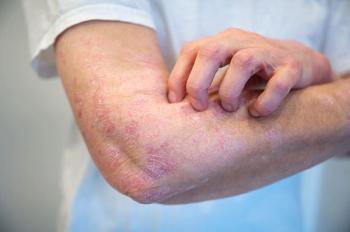
Middle-aged Hiker With Facial Paralysis
A 46-year-old man presents with right-sided facial paralysis. His symptoms beganthe previous evening when he had difficulty in closing his right eye; by morning,paralysis had developed. He also reports headache and mild photophobia.
A 46-year-old man presents with right-sided facial paralysis. His symptoms beganthe previous evening when he had difficulty in closing his right eye; by morning,paralysis had developed. He also reports headache and mild photophobia.
HISTORY
The patient has a history of genital herpes. Recently, he had a red rashwith a pale center; it resolved spontaneously about 2 weeks before the facialparalysis developed. He does not remember being bitten by a tick;however,he is an avid hiker and lives in southern New York State.
PHYSICAL EXAMINATION
He is afebrile and in no acute distress. The heart and lungs are normal.His face appears asymmetric: the right eyebrow sags, he is unable to close hisright eye (there is also decreased tearing in that eye), and his mouth is drawnto the left side; however, his tongue is midline. There are no lesions in oraround the ears. Results of the remainder of the cranial nerve examination andneurologic examination are normal. Kernig and Brudzinski signs are negative.No facial masses are evident, and there is no lymphadenopathy. No rashes or lesions are visible.Which of the following is the most likely cause of this man's symptoms?A. Lyme disease.B. Ramsay Hunt syndrome.C. Bell palsy.D. Parotid gland tumor.E. Guillain-Barr syndrome.CORRECT ANSWER: A
This patient lives in an area where Lyme disease ishighly prevalent. Moreover, he recently had a rash that resemblederythema chronicum migrans. This rash, whichappears in almost 90% of Lyme disease cases, is often describedas a "bull's eye" lesion: it has an erythematousborder around an area of central clearing. (Although centralclearing is a classic feature of erythema chronicummigrans, it is evident in only about 10% of these rashes.)The fact that he does not remember being bitten by a tickdoes not rule out Lyme disease; only about a third of patientsare able to recall a tick bite.Lyme disease may cause a neuropathy of any of thecranial nerves; however, the facial nerve is the most commonlyaffected. The neuropathy may be unilateral or bilateral.It can occur in the setting of meningitis or with otherneuropathies. Most-if not all-patients with a cranialneuropathy caused by Lyme disease have other clinicalmanifestations of Lyme infection.This patient has an isolated seventh cranial nervepalsy, a history of erythema chronicum migrans, andsymptoms of possible Lyme meningitis. In conjunctionwith his risk factors, these clinical findings point to Lymedisease (choice A) as the cause of his symptoms.Ramsay Hunt syndrome (choice B) is caused by thevaricella zoster virus (VZV) and consists of a triad ofsymptoms:
- Ipsilateral facial paralysis.
- Ear pain.
- Vesicular lesions in the auditory canal and auricle.
The syndrome is thought to result from reactivationof latent VZV in the geniculate ganglion. This reactivationgives rise to an inflammatory process that spreads to theeighth cranial nerve. The involvement of the eighth cranialnerve leads in turn to auditory and vestibular symptoms.Ramsay Hunt syndrome can be differentiated fromBell palsy and other forms of seventh cranial nerve palsyby the appearance of zoster-like lesions on the ear, whichare not present in this patient.In some patients, facial nerve paralysis caused byVZV is not associated with ear or mouth lesions. It isdemonstrated by a 4-fold increase in anti-VZV antibody inthe serum and is known as Ramsay Hunt syndrome zostersine herpete. It can be indistinguishable from idiopathicBell palsy. However, the absence of vertigo-as well as ofauricular vesicles-makes any form of the Ramsay Huntsyndrome unlikely in this patient. The isolated involvementof the facial nerve also makes this syndrome less likely;Ramsay Hunt syndrome is often a polyneuropathy and caninvolve any of cranial nerves V, VII, VIII, IX, and X.Bell palsy (choice C) is an idiopathic facial nervepalsy. It develops suddenly-often within 48 hours. A majorityof patients have a previous viral illness. The facialnerve palsy is unilateral and is not associated with any evidenceof pathology in the CNS, ear, or posterior cranialfossa. Approximately half of patients also experience ipsilateralear pain or numbness. Almost all patients have a diminishedstapedial reflex, and 25% have impaired taste asa result of involvement of the chorda tympani nerve.Bell palsy (choice C) is an idiopathic facial nervepalsy. It develops suddenly-often within 48 hours. A majorityof patients have a previous viral illness. The facialnerve palsy is unilateral and is not associated with any evidenceof pathology in the CNS, ear, or posterior cranialfossa. Approximately half of patients also experience ipsilateralear pain or numbness. Almost all patients have a diminishedstapedial reflex, and 25% have impaired taste asa result of involvement of the chorda tympani nerve.Patients with Bell palsy exhibit complete paralysis ofthe facial and platysmal muscles. Their eyebrows sag,they are unable to close the affected eye, and the mouth isdrawn away from the affected side. Bell palsy can be differentiatedfrom upper and lower motor neuron lesions byinclusion of the muscles of the forehead among those paralyzed.These muscles have bilateral innervation; thus,sparing of the forehead muscles indicates a central, uppermotor neuron lesion.This patient's symptoms are consistent with Bellpalsy. However, he has a history of an erythema chronicummigrans rash and likely exposure to ticks in an areawhere Lyme disease is endemic. Because Bell palsy isidiopathic, other causes of facial paralysis, such as Lymedisease, must be ruled out before it can be diagnosed.Tumors that invade the temporal bone can impingeon the facial nerve and cause a facial palsy. Examples ofsuch tumors include parotid gland tumors (choice D) andcholesteatoma. However, a tumor would not produce therapid onset of paralysis that is seen with other causes offacial nerve palsy-and which occurred in this patient.
The facial paralysis that is sometimes seen in Guillain-Barr syndrome (choice E) is bilateral rather thanunilateral and is associated with the ascending bodilyparalysis typical of this entity. Guillain-Barr syndrome isa highly unlikely cause of this patient's symptoms.
References:
FOR MORE INFORMATION:
- Schmutzhard E. Viral infections of the CNS with special emphasis on herpessimplex infections. J Neurol. 2001;248:469-471.
- Steere AC. Lyme disease. N Engl J Med. 2001;345:115-125.
- Sweeney CJ, Gilden DH. Ramsay Hunt syndrome. J Neurol Neurosurg Psychiatry.2001;71:149-154.
Newsletter
Enhance your clinical practice with the Patient Care newsletter, offering the latest evidence-based guidelines, diagnostic insights, and treatment strategies for primary care physicians.


















































































































































































































































































